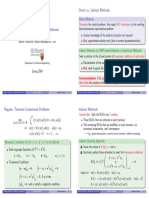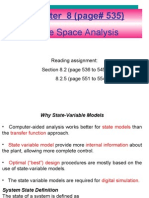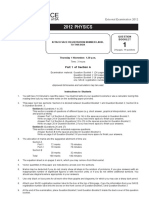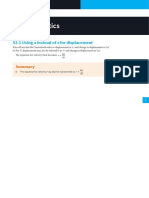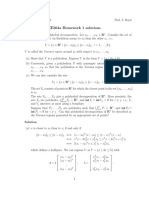Convex Optimization HW1 Solution
Uploaded by
Veritas208Convex Optimization HW1 Solution
Uploaded by
Veritas208EE364a, Winter 2012-13 Prof. S.
Boyd
EE364a Homework 1 solutions
2.9 Voronoi sets and polyhedral decomposition. Let x
0
, . . . , x
K
R
n
. Consider the set of
points that are closer (in Euclidean norm) to x
0
than the other x
i
, i.e.,
V = x R
n
[ |x x
0
|
2
|x x
i
|
2
, i = 1, . . . , K.
V is called the Voronoi region around x
0
with respect to x
1
, . . . , x
K
.
(a) Show that V is a polyhedron. Express V in the form V = x [ Ax _ b.
(b) Conversely, given a polyhedron P with nonempty interior, show how to nd
x
0
, . . . , x
K
so that the polyhedron is the Voronoi region of x
0
with respect to
x
1
, . . . , x
K
.
(c) We can also consider the sets
V
k
= x R
n
[ |x x
k
|
2
|x x
i
|
2
, i ,= k.
The set V
k
consists of points in R
n
for which the closest point in the set x
0
, . . . , x
K
is x
k
.
The sets V
0
, . . . , V
K
give a polyhedral decomposition of R
n
. More precisely, the
sets V
k
are polyhedra,
K
k=0
V
k
= R
n
, and int V
i
int V
j
= for i ,= j, i.e., V
i
and
V
j
intersect at most along a boundary.
Suppose that P
1
, . . . , P
m
are polyhedra such that
m
i=1
P
i
= R
n
, and int P
i
int P
j
= for i ,= j. Can this polyhedral decomposition of R
n
be described as
the Voronoi regions generated by an appropriate set of points?
Solution.
(a) x is closer to x
0
than to x
i
if and only if
|x x
0
|
2
|x x
i
|
2
(x x
0
)
T
(x x
0
) (x x
i
)
T
(x x
i
)
x
T
x 2x
T
0
x +x
T
0
x
0
x
T
x 2x
T
i
x +x
T
i
x
i
2(x
i
x
0
)
T
x x
T
i
x
i
x
T
0
x
0
,
which denes a halfspace. We can express V as V = x [ Ax _ b with
A = 2
(x
1
x
0
)
T
(x
2
x
0
)
T
.
.
.
(x
K
x
0
)
T
, b =
x
T
1
x
1
x
T
0
x
0
x
T
2
x
2
x
T
0
x
0
.
.
.
x
T
K
x
K
x
T
0
x
0
.
1
(b) Conversely, suppose V = x [ Ax _ b with A R
Kn
and b R
K
. We can
pick any x
0
x [ Ax b, and then construct K points x
i
by taking the mirror
image of x
0
with respect to the hyperplanes x [ a
T
i
x = b
i
. In other words, we
choose x
i
of the form x
i
= x
0
+ a
i
, where is chosen in such a way that the
distance of x
i
to the hyperplane dened by a
T
i
x = b
i
is equal to the distance of
x
0
to the hyperplane:
b
i
a
T
i
x
0
= a
T
i
x
i
b
i
.
Solving for , we obtain = 2(b
i
a
T
i
x
0
)/|a
i
|
2
2
, and
x
i
= x
0
+
2(b
i
a
T
i
x
0
)
|a
i
|
2
a
i
.
(c) A polyhedral decomposition of R
n
can not always be described as Voronoi regions
generated by a set of points x
1
, . . . , x
m
. The gure shows a counterexample in
R
2
.
P
1
P
2
P
3
P
4
P
1
P
2
H
1
H
2
R
2
is decomposed into 4 polyhedra P
1
, . . . , P
4
by 2 hyperplanes H
1
, H
2
. Suppose
we arbitrarily pick x
1
P
1
and x
2
P
2
. x
3
P
3
must be the mirror image of x
1
and x
2
with respect to H
2
and H
1
, respectively. However, the mirror image of x
1
with respect to H
2
lies in
P
1
, and the mirror image of x
2
with respect to H
1
lies
in
P
2
, so it is impossible to nd such an x
3
.
2.12 Which of the following sets are convex?
(a) A slab, i.e., a set of the form x R
n
[ a
T
x .
(b) A rectangle, i.e., a set of the form x R
n
[
i
x
i
i
, i = 1, . . . , n. A
rectangle is sometimes called a hyperrectangle when n > 2.
(c) A wedge, i.e., x R
n
[ a
T
1
x b
1
, a
T
2
x b
2
.
2
(d) The set of points closer to a given point than a given set, i.e.,
x [ |x x
0
|
2
|x y|
2
for all y S
where S R
n
.
(e) The set of points closer to one set than another, i.e.,
x [ dist(x, S) dist(x, T),
where S, T R
n
, and
dist(x, S) = inf|x z|
2
[ z S.
(f) The set x [ x +S
2
S
1
, where S
1
, S
2
R
n
with S
1
convex.
(g) The set of points whose distance to a does not exceed a xed fraction of the
distance to b, i.e., the set x [ |x a|
2
|x b|
2
. You can assume a ,= b and
0 1.
Solution.
(a) A slab is an intersection of two halfspaces, hence it is a convex set (and a poly-
hedron).
(b) As in part (a), a rectangle is a convex set and a polyhedron because it is a nite
intersection of halfspaces.
(c) A wedge is an intersection of two halfspaces, so it is convex set. It is also a
polyhedron. It is a cone if b
1
= 0 and b
2
= 0.
(d) This set is convex because it can be expressed as
yS
x [ |x x
0
|
2
|x y|
2
,
i.e., an intersection of halfspaces. (For xed y, the set
x [ |x x
0
|
2
|x y|
2
is a halfspace; see exercise 2.9).
(e) In general this set is not convex, as the following example in R shows. With
S = 1, 1 and T = 0, we have
x [ dist(x, S) dist(x, T) = x R [ x 1/2 or x 1/2
which clearly is not convex.
3
(f) This set is convex. x +S
2
S
1
if x +y S
1
for all y S
2
. Therefore
x [ x +S
2
S
1
=
yS
2
x [ x +y S
1
=
yS
2
(S
1
y),
the intersection of convex sets S
1
y.
(g) The set is convex, in fact a ball.
x [ |x a|
2
|x b|
2
= x [ |x a|
2
2
2
|x b|
2
2
= x [ (1
2
)x
T
x 2(a
2
b)
T
x + (a
T
a
2
b
T
b) 0
If = 1, this is a halfspace. If < 1, it is a ball
x [ (x x
0
)
T
(x x
0
) R
2
,
with center x
0
and radius R given by
x
0
=
a
2
b
1
2
, R =
2
|b|
2
2
|a|
2
2
1
2
+|x
0
|
2
2
1/2
.
2.15 Some sets of probability distributions. Let x be a real-valued random variable with
prob(x = a
i
) = p
i
, i = 1, . . . , n, where a
1
< a
2
< < a
n
. Of course p R
n
lies in
the standard probability simplex P = p [ 1
T
p = 1, p _ 0. Which of the following
conditions are convex in p? (That is, for which of the following conditions is the set of
p P that satisfy the condition convex?)
(a) Ef(x) , where Ef(x) is the expected value of f(x), i.e., Ef(x) =
n
i=1
p
i
f(a
i
). (The function f : R R is given.)
(b) prob(x > ) .
(c) E[x
3
[ E[x[.
(d) Ex
2
.
(e) Ex
2
.
(f) var(x) , where var(x) = E(x Ex)
2
is the variance of x.
(g) var(x) .
(h) quartile(x) , where quartile(x) = inf [ prob(x ) 0.25.
(i) quartile(x) .
Solution. We rst note that the constraints p
i
0, i = 1, . . . , n, dene halfspaces,
and
n
i=1
p
i
= 1 denes a hyperplane, so P is a polyhedron.
The rst ve constraints are, in fact, linear inequalities in the probabilities p
i
.
4
(a) Ef(x) =
n
i=1
p
i
f(a
i
), so the constraint is equivalent to two linear inequalities
n
i=1
p
i
f(a
i
) .
(b) prob(x ) =
i: a
i
p
i
, so the constraint is equivalent to a linear inequality
i: a
i
p
i
.
(c) The constraint is equivalent to a linear inequality
n
i=1
p
i
([a
3
i
[ [a
i
[) 0.
(d) The constraint is equivalent to a linear inequality
n
i=1
p
i
a
2
i
.
(e) The constraint is equivalent to a linear inequality
n
i=1
p
i
a
2
i
.
The rst ve constraints therefore dene convex sets.
(f) The constraint
var(x) = Ex
2
(Ex)
2
=
n
i=1
p
i
a
2
i
(
n
i=1
p
i
a
i
)
2
is not convex in general. As a counterexample, we can take n = 2, a
1
= 0, a
2
= 1,
and = 1/5. p = (1, 0) and p = (0, 1) are two points that satisfy var(x) ,
but the convex combination p = (1/2, 1/2) does not.
(g) This constraint is equivalent to
n
i=1
p
i
a
2
i
(
n
i=1
p
i
a
i
)
2
= b
T
p p
T
Ap ,
where b
i
= a
2
i
and A = aa
T
. We write this as
p
T
Ap b
T
p + 0.
This denes a convex set, since the matrix aa
T
is positive semidenite.
5
To show this set is convex for A S
+
, we rst make the observation that
x
T
Ay
x
T
Ax +y
T
Ay
2
which follows from (x y)
T
A(x y) 0. Now choose x, y ( and show z =
x + (1 )y (:
z
T
Az +b
T
z +
=
2
x
T
Ax + (1 )
2
y
T
Ay + 2(1 )x
T
Ay +b
T
(x + (1 )y) +
2
x
T
Ax + (1 )
2
y
T
Ay +(1 )(x
T
Ax +y
T
Ay) +b
T
(x + (1 )y) +
= x
T
Ax +b
T
x + (1 )y
T
Ay + (1 )b
T
y + + (1 )
= (x
T
Ax +b
T
x +) + (1 )(y
T
Ay +b
T
y +)
0
Therefore z ( and the set is convex.
Let us denote quartile(x) = f(p) to emphasize it is a function of p. The gure
illustrates the denition. It shows the cumulative distribution for a distribution p with
f(p) = a
2
.
prob(x )
a
1
a
2
a
n
p
1
p
1
+p
2
p
1
+p
2
+ +p
n1
0.25
1
(h) The constraint f(p) is equivalent to
prob(x ) < 0.25 for all < .
If a
1
, this is always true. Otherwise, dene k = maxi [ a
i
< . This is a
xed integer, independent of p. The constraint f(p) holds if and only if
prob(x a
k
) =
k
i=1
p
i
< 0.25.
This is a strict linear inequality in p, which denes an open halfspace.
6
(i) The constraint f(p) is equivalent to
prob(x ) 0.25 for all .
Here, let us dene k = maxi [ a
i
. Again, this is a xed integer, independent
of p. The constraint f(p) holds if and only if
prob(x a
k
) =
k
i=1
p
i
0.25.
If < a
1
, then no p satises f(p) , which means that the set is empty. Thus,
the constraint f(p) is a linear inequality on p.
2.23 Give an example of two closed convex sets that are disjoint but cannot be strictly
separated.
Solution. Take C = x R
2
[ x
2
0 and D = x R
2
+
[ x
1
x
2
1.
2.28 Positive semidenite cone for n = 1, 2, 3. Give an explicit description of the positive
semidenite cone S
n
+
, in terms of the matrix coecients and ordinary inequalities, for
n = 1, 2, 3. To describe a general element of S
n
, for n = 1, 2, 3, use the notation
x
1
,
x
1
x
2
x
2
x
3
x
1
x
2
x
3
x
2
x
4
x
5
x
3
x
5
x
6
.
Solution. A symmetric matrix X is positive semidenite if and only if all principal
minors (determinants of symmetric submatrices) are nonnegative. For n = 1 the
condition is just x
1
0. For n = 2 the condition is
x
1
0, x
3
0, x
1
x
3
x
2
2
0.
For n = 3 the condition is
x
1
0, x
4
0, x
6
0, x
1
x
4
x
2
2
0, x
4
x
6
x
2
5
0, x
1
x
6
x
2
3
0
and
x
1
x
4
x
6
+ 2x
2
x
3
x
5
x
1
x
2
5
x
6
x
2
2
x
4
x
2
3
0.
7
You might also like
- Hourglass Workout Program by Luisagiuliet 276% (21)Hourglass Workout Program by Luisagiuliet 251 pages
- The Hold Me Tight Workbook - Dr. Sue Johnson100% (16)The Hold Me Tight Workbook - Dr. Sue Johnson187 pages
- Read People Like A Book by Patrick King-Edited62% (65)Read People Like A Book by Patrick King-Edited12 pages
- Livingood, Blake - Livingood Daily Your 21-Day Guide To Experience Real Health77% (13)Livingood, Blake - Livingood Daily Your 21-Day Guide To Experience Real Health260 pages
- COSMIC CONSCIOUSNESS OF HUMANITY - PROBLEMS OF NEW COSMOGONY (V.P.Kaznacheev,. Л. V. Trofimov.)94% (212)COSMIC CONSCIOUSNESS OF HUMANITY - PROBLEMS OF NEW COSMOGONY (V.P.Kaznacheev,. Л. V. Trofimov.)212 pages
- Donald Trump & Jeffrey Epstein Rape Lawsuit and Affidavits83% (1016)Donald Trump & Jeffrey Epstein Rape Lawsuit and Affidavits13 pages
- The 36 Questions That Lead To Love - The New York Times94% (34)The 36 Questions That Lead To Love - The New York Times3 pages
- The 36 Questions That Lead To Love - The New York Times95% (21)The 36 Questions That Lead To Love - The New York Times3 pages
- Jeffrey Epstein39s Little Black Book Unredacted PDF75% (12)Jeffrey Epstein39s Little Black Book Unredacted PDF95 pages
- The 4 Hour Workweek, Expanded and Updated by Timothy Ferriss - Excerpt23% (954)The 4 Hour Workweek, Expanded and Updated by Timothy Ferriss - Excerpt38 pages
- Advanced Signal Processing Introduction To Estimation TheoryNo ratings yetAdvanced Signal Processing Introduction To Estimation Theory40 pages
- Optimal Control Lecture 28: Indirect Solution MethodsNo ratings yetOptimal Control Lecture 28: Indirect Solution Methods2 pages
- Chapter 1 - Introduction To Computer NetworksNo ratings yetChapter 1 - Introduction To Computer Networks53 pages
- Mean Variance MGF and CF of DistributionsNo ratings yetMean Variance MGF and CF of Distributions9 pages
- Pakistan International School (English Section) : RiyadhNo ratings yetPakistan International School (English Section) : Riyadh8 pages
- Module - 1 Lecture Notes - 2 Optimization Problem and Model FormulationNo ratings yetModule - 1 Lecture Notes - 2 Optimization Problem and Model Formulation5 pages
- Non Linear Optimization in EENG Lecture - 00No ratings yetNon Linear Optimization in EENG Lecture - 0018 pages
- Convex Optimization With Engineering Applications100% (1)Convex Optimization With Engineering Applications38 pages
- 2022 1MA2 Applications of Differentiation - Notes (Students)No ratings yet2022 1MA2 Applications of Differentiation - Notes (Students)21 pages
- Worksheet 102 - Solving Trigonometric EquationsNo ratings yetWorksheet 102 - Solving Trigonometric Equations2 pages
- 2b. TECHNIQUES OF INTEGRATION by Substitution With ExampleNo ratings yet2b. TECHNIQUES OF INTEGRATION by Substitution With Example31 pages
- Probability Practice 2 (Discrete & Continuous Distributions)No ratings yetProbability Practice 2 (Discrete & Continuous Distributions)13 pages
- Solved Examples Type I. Problems Based On Direct Use of Rules of Integration and Formulae For Standard IntegralsNo ratings yetSolved Examples Type I. Problems Based On Direct Use of Rules of Integration and Formulae For Standard Integrals2 pages
- Further Pure 1 Revision Topic 1: Complex NumbersNo ratings yetFurther Pure 1 Revision Topic 1: Complex Numbers41 pages
- JJC JC 2 H2 Maths 2011 Mid Year Exam SolutionsNo ratings yetJJC JC 2 H2 Maths 2011 Mid Year Exam Solutions14 pages
- Mathematics of Cryptography: Part I: Modular Arithmetic, Congruence, and MatricesNo ratings yetMathematics of Cryptography: Part I: Modular Arithmetic, Congruence, and Matrices78 pages
- Tutorial-8-MEP311-Sheet-5-Chemical Kinetics Sheet-6-Spontaneous IgnitionNo ratings yetTutorial-8-MEP311-Sheet-5-Chemical Kinetics Sheet-6-Spontaneous Ignition18 pages
- A Level Mathematics - Practice Paper - 7.4 - Differentiation in ContextNo ratings yetA Level Mathematics - Practice Paper - 7.4 - Differentiation in Context9 pages
- 2020 JC 2 H2 Math Consolidation Test II (Solutions)No ratings yet2020 JC 2 H2 Math Consolidation Test II (Solutions)13 pages
- Fractions Class 6 Notes CBSE Maths Chapter 7 (PDF)No ratings yetFractions Class 6 Notes CBSE Maths Chapter 7 (PDF)5 pages
- Parallel Lines Proofs and Mixed Practice 2022-2023No ratings yetParallel Lines Proofs and Mixed Practice 2022-20236 pages
- Delhi Public School Bangalore - East Mathematics Coordinate Geometry - Worksheet NAME: - CLASS: IX SEC: - DATENo ratings yetDelhi Public School Bangalore - East Mathematics Coordinate Geometry - Worksheet NAME: - CLASS: IX SEC: - DATE2 pages
- 99.poultry Breeding and Multiplication Center OkNo ratings yet99.poultry Breeding and Multiplication Center Ok21 pages
- Map Server For Visualizing Air Traffic Based On Data From A Remote Pseudo RadarNo ratings yetMap Server For Visualizing Air Traffic Based On Data From A Remote Pseudo Radar14 pages
- Initiate and Complete A Journal Entry Document Via Park Document (Document Types SA or ZB)No ratings yetInitiate and Complete A Journal Entry Document Via Park Document (Document Types SA or ZB)18 pages
- Session 3 (Quantitative Techniques - Sample Paper 2)No ratings yetSession 3 (Quantitative Techniques - Sample Paper 2)14 pages
- CSEC - Nutrition Powerpoint Scribd VERSION100% (1)CSEC - Nutrition Powerpoint Scribd VERSION20 pages
- Chapter 4 Mechanical Properties of MetalsNo ratings yetChapter 4 Mechanical Properties of Metals19 pages
- MODELS 373LAV, 376CAV Downflow/Horizontal and 383kav, 395cav Upflow Gas Furnace50% (2)MODELS 373LAV, 376CAV Downflow/Horizontal and 383kav, 395cav Upflow Gas Furnace12 pages
- COMMS207 Research Worksheet #2 Jade JugumNo ratings yetCOMMS207 Research Worksheet #2 Jade Jugum2 pages
- Performance Assessment and Review Admin and Accounts ManagersNo ratings yetPerformance Assessment and Review Admin and Accounts Managers3 pages
- CBSE Sample Paper Class 7 Maths Half Yearly Set 1100% (1)CBSE Sample Paper Class 7 Maths Half Yearly Set 15 pages
- Livingood, Blake - Livingood Daily Your 21-Day Guide To Experience Real HealthLivingood, Blake - Livingood Daily Your 21-Day Guide To Experience Real Health
- COSMIC CONSCIOUSNESS OF HUMANITY - PROBLEMS OF NEW COSMOGONY (V.P.Kaznacheev,. Л. V. Trofimov.)COSMIC CONSCIOUSNESS OF HUMANITY - PROBLEMS OF NEW COSMOGONY (V.P.Kaznacheev,. Л. V. Trofimov.)
- Donald Trump & Jeffrey Epstein Rape Lawsuit and AffidavitsDonald Trump & Jeffrey Epstein Rape Lawsuit and Affidavits
- The 36 Questions That Lead To Love - The New York TimesThe 36 Questions That Lead To Love - The New York Times
- The 36 Questions That Lead To Love - The New York TimesThe 36 Questions That Lead To Love - The New York Times
- Jeffrey Epstein39s Little Black Book Unredacted PDFJeffrey Epstein39s Little Black Book Unredacted PDF
- The 4 Hour Workweek, Expanded and Updated by Timothy Ferriss - ExcerptThe 4 Hour Workweek, Expanded and Updated by Timothy Ferriss - Excerpt
- Advanced Signal Processing Introduction To Estimation TheoryAdvanced Signal Processing Introduction To Estimation Theory
- Optimal Control Lecture 28: Indirect Solution MethodsOptimal Control Lecture 28: Indirect Solution Methods
- Pakistan International School (English Section) : RiyadhPakistan International School (English Section) : Riyadh
- Module - 1 Lecture Notes - 2 Optimization Problem and Model FormulationModule - 1 Lecture Notes - 2 Optimization Problem and Model Formulation
- 2022 1MA2 Applications of Differentiation - Notes (Students)2022 1MA2 Applications of Differentiation - Notes (Students)
- 2b. TECHNIQUES OF INTEGRATION by Substitution With Example2b. TECHNIQUES OF INTEGRATION by Substitution With Example
- Probability Practice 2 (Discrete & Continuous Distributions)Probability Practice 2 (Discrete & Continuous Distributions)
- Solved Examples Type I. Problems Based On Direct Use of Rules of Integration and Formulae For Standard IntegralsSolved Examples Type I. Problems Based On Direct Use of Rules of Integration and Formulae For Standard Integrals
- Mathematics of Cryptography: Part I: Modular Arithmetic, Congruence, and MatricesMathematics of Cryptography: Part I: Modular Arithmetic, Congruence, and Matrices
- Tutorial-8-MEP311-Sheet-5-Chemical Kinetics Sheet-6-Spontaneous IgnitionTutorial-8-MEP311-Sheet-5-Chemical Kinetics Sheet-6-Spontaneous Ignition
- A Level Mathematics - Practice Paper - 7.4 - Differentiation in ContextA Level Mathematics - Practice Paper - 7.4 - Differentiation in Context
- 2020 JC 2 H2 Math Consolidation Test II (Solutions)2020 JC 2 H2 Math Consolidation Test II (Solutions)
- Fractions Class 6 Notes CBSE Maths Chapter 7 (PDF)Fractions Class 6 Notes CBSE Maths Chapter 7 (PDF)
- Parallel Lines Proofs and Mixed Practice 2022-2023Parallel Lines Proofs and Mixed Practice 2022-2023
- Delhi Public School Bangalore - East Mathematics Coordinate Geometry - Worksheet NAME: - CLASS: IX SEC: - DATEDelhi Public School Bangalore - East Mathematics Coordinate Geometry - Worksheet NAME: - CLASS: IX SEC: - DATE
- Map Server For Visualizing Air Traffic Based On Data From A Remote Pseudo RadarMap Server For Visualizing Air Traffic Based On Data From A Remote Pseudo Radar
- Initiate and Complete A Journal Entry Document Via Park Document (Document Types SA or ZB)Initiate and Complete A Journal Entry Document Via Park Document (Document Types SA or ZB)
- Session 3 (Quantitative Techniques - Sample Paper 2)Session 3 (Quantitative Techniques - Sample Paper 2)
- MODELS 373LAV, 376CAV Downflow/Horizontal and 383kav, 395cav Upflow Gas FurnaceMODELS 373LAV, 376CAV Downflow/Horizontal and 383kav, 395cav Upflow Gas Furnace
- Performance Assessment and Review Admin and Accounts ManagersPerformance Assessment and Review Admin and Accounts Managers




































